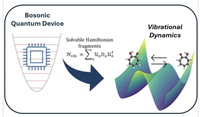Publication Date: February 14, 2025
Authors:
Shreyas Malpathak, Sangeeth Das Kallullathil, and Artur F. Izmaylov
Abstract:
Bosonic quantum devices, which utilize harmonic oscillator modes to encode information, are emerging as a promising alternative to conventional qubit-based quantum devices, especially for the simulation of vibrational dynamics and spectroscopy. We present a framework for digital quantum simulation of vibrational dynamics under anharmonic potentials on these bosonic devices. In our approach, the vibrational Hamiltonian is decomposed into solvable fragments that can be used for Hamiltonian simulation on currently available bosonic hardware. Specifically, we have extended the Cartan subalgebra approach [Yen, T.C.; Izmaylov, A. F. PRX Quantum 2, 2021; 040320]− a method for decomposing quantum Hamiltonians into solvable parts− to bosonic operators, enabling us to construct anharmonic Hamiltonian fragments that can be efficiently diagonalized using Bogoliubov transforms. The approach is tested using a simulation of tunneling dynamics in a model two-dimensional double-well potential and calculations of vibrational eigenenergies for small molecules. Our fragmentation scheme provides a new approach for digital quantum simulations on bosonic quantum hardware for multimode anharmonic vibrational dynamics.
Related links:
Read this publication on The Journal of Physical Chemistry Letters website

